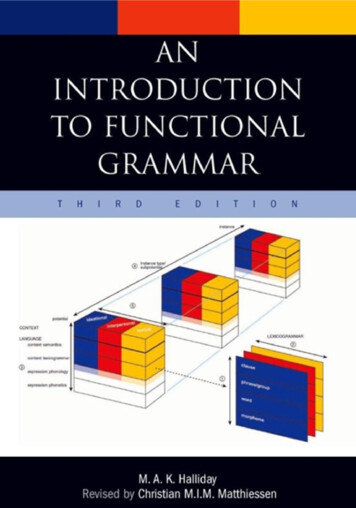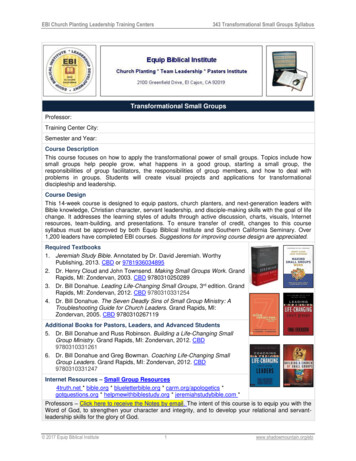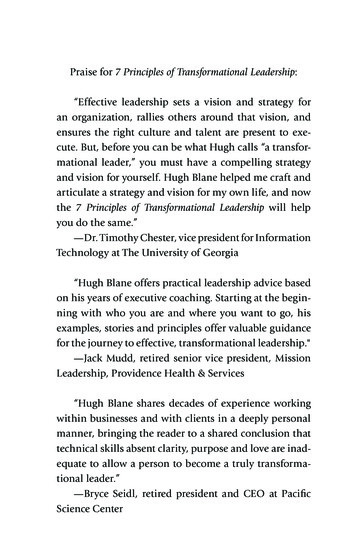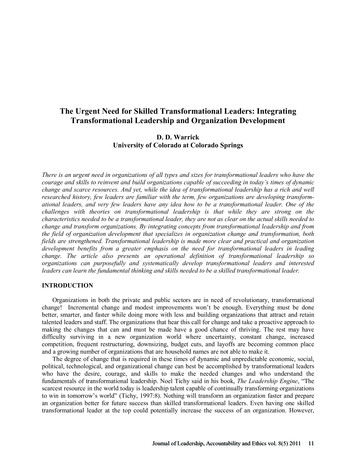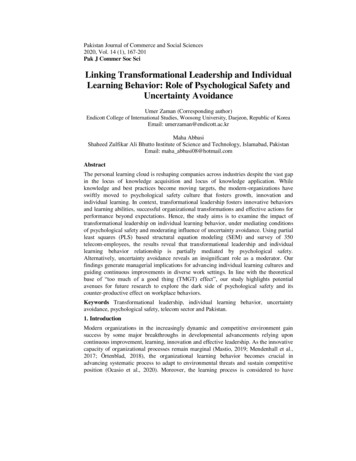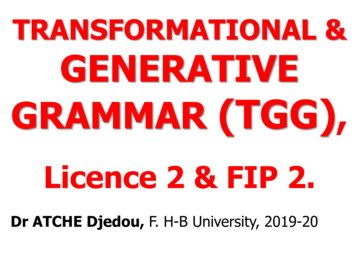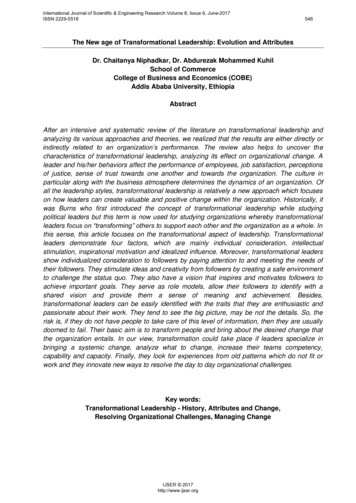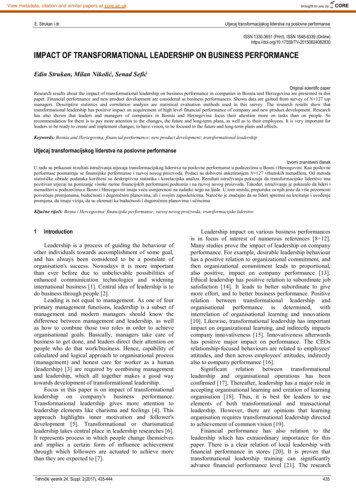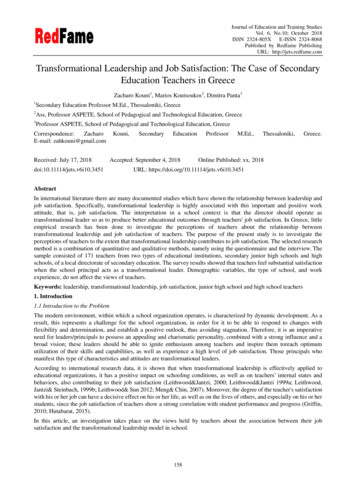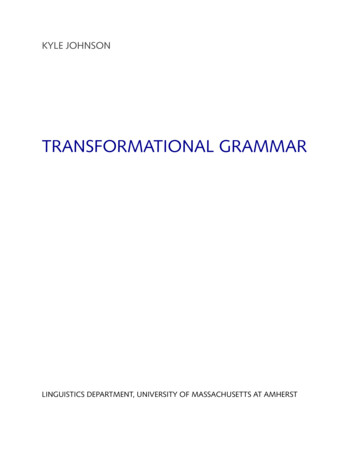
Transcription
KYLE JOHNSONTRANSFORMATIONAL GRAMMARLINGUISTICS DEPARTMENT, UNIVERSITY OF MASSACHUSETTS AT AMHERST
Copyright 2013 Kyle Johnsonversion: September 2013
ContentsThe Subject11Linguistics as learning theoryThe evidential basis of syntactic theory15Phrase StructureSubstitution ClassesPhrases1823Recursive Phrases34Arguments and Modifiers45Deriving Phrase Structure RulesBibliography61546
PrefaceThese are the always evolving notes from an introductory course on syntactictheory taught at the University of Massachusetts at Amherst. Its target audience is first-year graduate students. No background exposure to syntax ispresupposed.
The SubjectLinguistic theory, and so syntactic theory, has been very heavily influencedby learnability considerations in the last fifty-some years, thanks largely tothe writings of Noam Chomsky. If we decide that syntactic theory is chargedwith the duty of modeling our knowledge of language, then we can makesome initial deductions about what this knowledge, and therefore our modelof it, should look like from some simple observations. This knowledge mustinteract efficiently with the cognitive mechanisms involved in producing andcomprehending speech, for instance. It must also be acquirable by any normalinfant exposed to speakers of the language over six or so years. A numberof considerations combine to make the task of acquiring knowledge of alanguage look very difficult indeed: the complexity of the acquired grammar,the amount of information that needs to be acquired, the attenuated natureof the information available to the child, etc. It is made even more puzzlingby the fact that children appear to complete this task with relative ease in acomparatively short period of time and that the course of acquisition appearsto go through a set schedule of stages. There is clearly a problem: If languagesare as complex as we think they are, then how can these impossibly complexobjects possibly be learned?Linguistics as learning theoryIt is Chomsky’s proposal that Syntactic Theory itself should contribute tosolving this dilemma. The classical formulation of this idea (see Aspects andThe Sound Pattern of English) characterizes the situation as follows. Think of agrammar of L (GL ) (this is what Chomsky (1986b) calls “I-Language”) as a setof rules that generates structural descriptions of the strings of the language L(Chomsky (1986b)’s E-language). Our model of this grammar is descriptivelyadequate if it assigns the same structural descriptions to the strings of L thatGL does. We can think of the learning process as involving a selection fromthe Universe of GL s the very one that generates these structured strings of theL to be acquired.The learning problem can now be stated in the following terms: how is itthat the learning procedure is able to find GL when the universe of Gs is sohuge and the evidence steering the device so meager.
2 Transformational GrammarOne step towards solving this problem would be to hypothesize that theuniverse of Gs has a structure that enables convergence on GL given the sortof information that the child is exposed to. This is Chomsky’s proposal. Itamounts to the claim that there are features of Gs which are built-in: certainproperties which distinguish the natural class of Gs from the rest. There is akind of meta-grammar of the Gs, then, which is sometimes referred to withthe label Universal Grammar. Chomsky further hypothesizes that these properties are biologically given: that it is something about the construction ofthe human brain/mind that is responsible for the fact that the class of Gs arethe way they are. This argument, the one that leads from the observation thatGL s have features that are too complex to be learned to the conclusion thatthe universe of Gs is constrained is often called “The Poverty of the Stimulus”argument. It is a classic from Epistemology, imported with specific force byChomsky into linguistics.This way of setting up the problem, note, allows for the Universe of Gsto be larger than the learnable Gs. There could, for instance, be constraintsimposed by the parsing and production procedures which limit the set ofGs that can be attained. And it’s conceivable that there are properties of thelearning procedure itself — properties that are independent of the structure of Gs imposed by Universal Grammar — that could place a limit on thelearnable Gs. Universal Grammar places an outside bound on the learnablegrammars, but it needn’t be solely responsible for fitting the actual outlines ofthat boundary. It’s therefore a little misleading to say that the set of “learnableGs” are those characterized by Universal Grammar, since there may be theseother factors involved in determining whether a grammar is learnable or not.I should probably say that Universal Grammar carves out the “available Gs,”or something similar. But I will instead be misleading, and describe UniversalGrammar as fixing the set of learnable Gs, always leaving tacit that this is justgrammar’s contribution to the learnability question.Chomsky proposes, then, that a goal of syntactic theory should be tocontribute towards structuring the universe of Gs. He makes some specificproposals about how to envision this in Aspects of The Theory of Syntax. Hesuggests that syntactic theory should include an evaluation metric which“ranks” Gs. A syntactic theory that has this feature he calls explanatory. Thus“explanatory theory” has a specific, technical, sense in linguistic theory. Atheory is explanatory if and only if it encapsulates the features that ranks Gsin such a way that it contributes to the learnability problem, distinguish thelearnable Gs from the unlearnable ones. This criterion can help the syntactician decide whether the model of GL he or she has proposed correspondsexactly to GL . In particular, the many descriptively adequate models of GLcan be distinguished on this basis: we should select only those that are rankedhighly by the evaluation metric. These grammars meet the criterion of explanatory adequacy.
The SubjectA very important role, therefore, is played by the evaluation metric. At thetime of Aspects, the learning procedure was conceived of as a process verymuch like that which the linguist goes through. The child builds a batteryof rules which generate the strings of L. The evaluation metric steering thisprocess was thought to have essentially two parts: a simplicity metric, whichguides the procedure in its search through the space of grammars, and inviolable constraints, which partitions the set of Gs into the learnable onesand the unlearnable ones. Thus, for example, we might imagine that ruleswhich used fewer symbols could be defined as “simpler” than ones that useda greater number of symbols. Inviolable constraints might be those, for example, expressed as part of the principles which place constraints on the waythat strings can be partitioned into groups, and therefore simply removesfrom the universe of Gs a great many possible Gs. Let’s call these models ofGs “rule based,” because the simplicity metric is defined as a procedure thatconstructs rules, and the companion picture of the acquisition process the“Little Linguist” model.To take a concrete example, imagine that the principles which limit howwords are strung into groups — one particular version of which goes by thename “X Theory” — imposes the following constraints.XP { (ZP), X }X { X, (YP) }X { X , (WP) }Understand “{α, β}” to signify that α and β are sisters, and “(α)” to indicatethat α is optional. Let W, X, Y and Z range over kinds of lexical items (e.g.,“noun,” “verb,” “preposition,” and so on). And, finally, let “ ” mean: “consistsof.” The groups here, known as phrases, are the XP and X in the formulas.These constraints, then, leave to the learner only the matter of filling in thevariables W, X, Y and Z, and discovering their linear order. As the child goesfrom step to step in matching the grammar he or she is constructing with theinformation coming in, these are the only decisions that have to be made.If we imagine that this set of options were to be operationalized into a concrete decision tree, then we could see this as constituting a kind of “simplicitymetric.” It would constitute a procedure for searching through the space oflearnable grammars that imposes an order on the grammars, enabling a deterministic method for converging at a particular grammar when exposed toa particular linguistic environment. Additionally, X Theory provides an absolute cap on the possible phrases and, in this respect, constitutes an inviolableconstraint as well. If every language learner is equipped with this X Theory,then they will converge more or less on the same GL when presented with theinformation that being in the environment of speakers of L provides. If thereare differences in the GL ’s that learners converge on, these will trace back todifferent decisions these learners have made about the identity of W, X, Y andZ, or how their linear order is determined. If the rest of a model that incorpo-3
4Transformational Grammarrates these constraints is correct, then, it should allow any language learner topick out a GL very close to the GL giving shape to the speech in that learner’senvironment.Let’s consider another example involving transformational rules, one thatChomsky often points to. Transformational rules map one syntactic representation, D-structure, to another, S-structure, typically by way of movingconstituents. Interestingly, it appears that all such rules are “structure dependent.” That is, they make reference to the relative structural positions of themoved thing and the position it is moved to. They don’t, for example, makereference to points in a string on the basis of their position relative to somenumerical count of formatives. Thus “Wh-Movement” moves maximal projections that meet certain criteria to particular positions in a phrase marker. Andthis operation is governed by a set of constraints that make reference to therelation between these points solely in terms of structure. There is no rule, forexample, like Wh-Movement but which affects terms based on how far apartthey are numerically. Thus, the learning procedure will never have to entertainthe hypothesis that GL should contain such rules.In both cases, the classic argument for distinguishing the inviolable constraint from the simplicity metric follows very closely the logic of the povertyof stimulus argument. Because it is difficult to see (maybe even provably impossible) how such things as X Theory or structure dependence could belearned, they must belong to the features that define the universe of Gs. Andbecause they are overarching properties of the rules in some GL , they alsohave the right form to be inviolable constraints.There is another argument towards the same end which has gained increasing influence in the last couple decades; and this one comes to us through thenarrowly linguistic study of language typology, and only tangentially fromlearnability considerations. I will call it “Humboldt’s argument,” though it nodoubt has an earlier champion. Humboldt’s argument is based on the observation that there are certain properties that appear to hold true of all GL s. Thiscan be explained, Humboldt argues, only if the universe of Gs is constrainedto just those which have the relevant, universal, properties. Like Chomsky,Humboldt relates this to the construction of the mind, and uses the languageof learnability in his account. He puts it this way:Since the natural inclination to language is universal to man, and since allmen must carry the key to the understanding of all languages in their minds,it follows automatically that the form of all languages must be fundamentallyidentical and must always achieve a common objective. The variety amonglanguages can lie only in the media and the limits permitted the attainment ofthe objective.(von Humboldt 1836)(One might read the last sentence of this passage as making the distinction,touched on above, between aspects of Universal Grammar (“the media”) andthe limits our cognition places on exploiting UG (“the limits permitted the
The Subjectattainment of the objective”).) So, like Chomsky, he supposes that there is aUniversal Grammar, a feature of the mind, which constrains the form thatlanguages may have. But his perspective is different from Chomsky’s. Heexpresses the notion of Universal Grammar not in terms of learning theory,or through the glass of the Poverty of the Stimulus argument, but from theperspective of language variability. He links limits on language variability to auniversal ability he sees in human psychology to acquire a language.Humboldt’s goal is an explanation for the observed limits in variability ofthe grammars of extant languages. One might imagine that there are explanations for these limits that do not involve, as Humboldt proposes, constraintsimposed by human psychology. Similarities in extant languages might reflecttheir common ancestry: if all languages descend from a common one, thenfeatures that are shared among them could simply be vestiges of the ancestrallanguage that historical change has left untouched. This is the thesis of monogenesis. I think it’s possible to read Sapir as advancing this alternative. Sapiris commonly associated with the position exactly opposite to Humboldt’s; inSapir’s words:Speech is a human activity that varies without assignable limit as we pass fromsocial group to social group, because it is a purely historical heritage of thegroup, the product of long-continued social usage.(Sapir, 1921, p. 4)But, perhaps because of his vagueness, it’s possible to credit Sapir with a moresophisticated view. One that assigns the universal properties of languages tothe detritus of historical change:For it must be obvious to any one who has thought about the question at all orwho has felt something of the spirit of a foreign language that there is such athing as a basic plan, a certain cut, to each language. . . . Moreover, the historicalstudy of language has proven to us beyond all doubt that a language changesnot only gradually but consistently, that it moves unconsciously from one typetowards another, and that analogous trends are observable in remote quarters ofthe globe.(Sapir, 1921, pp. 120-121)Perhaps the common properties of extant (and known) languages are a function of two facts: all languages descend from a common language, and theforces that cause languages to change are not fully random — they preservecertain features and change others only according to some “basic plan.” If historical relatedness is to explain the common traits that extant languages have,some limit must be placed on how languages change and diverge. Otherwise,language change would act as a kind of randomizer that, over time, woulddestroy the limits in variability that we observe. Mongenesis needs to be coupled, then, with a theory of diachrony that characterizes the limits it imposeson change. Could it be, then, that the similarities in languages are all due tothese laws of diachrony?5
6 Transformational GrammarThis seems to me to be a coherent account for language variability. But itmay be just a disguised version of the Chomsky/Humboldt hypothesis thatthe limits of human cognition are responsible for the constraints on linguisticvariation. The thesis of monogenesis entails that language variation is solelythe product of historical change, as Sapir’s quotes makes clear. So we expectthat languages vary in features which historical change can affect, but willremain similar in those ways that are immutable. Which of the features appearas language universals, then, is determined by the internal mechanisms ofhistorical change, and the limits thereon. What are the internal mechanismsof historical change? The only proposal I know of is that historical change isa by-product of language acquisition. It is the accumulation of the small mismatches in GL s that successive generations of language acquirers select. Language acquisition, the poverty of the stimulus argument tells us, is guided byUniversal Grammar. So even granting the diachronic argument for languageuniversals, we see that as historical change weeds out the mutable propertiesfrom the immutable ones, the properties it leaves are those that characterizeUniversal Grammar. The antidote for the argument I have blamed on Sapir,then, involves bringing the poverty of the stimulus argument into play. I don’tknow if Humboldt’s argument can stand against this alternative unaided.But even if it can’t, it provides us with another way of viewing how to factorout the components of the evaluation metric. Following the logic of Humboldt’s argument, what we expect is that language comparison should give usa means of separating inviolable constraints from the evaluation metric. Theinviolable constraints will be (among) those things found in all languages;the differences in languages are to be credited to the evaluation metric. Putsomewhat differently, an explanatory theory is to give us both how languagescannot be constructed, and how their construction can vary. The data it mustfit, then, emerges only once languages are compared: for not only does thisallow the universals to be clearly discerned, but it is only through this meansthat the particulars of language variation are known.When this method of factoring out the universals in Gs is followed inearnest, a rather different picture of various GL s emerges; and a very differentconception of the language acquisition procedure becomes available. Thiscourse is meant to illustrate these emerging pictures in detail.The evidential basis of syntactic theoryIf linguistics is one part of the study of human cognition, in the sense just described, then syntax can be described as that subdiscipline of linguistics whichseeks to discover what speakers know about how to arrange the words of theirlanguage into meaningful sentences. Because speakers are not conscious ofthe principles that characterize this knowledge, the syntactician must makerecourse to indirect means of determining these principles. The syntactician’sfirst task, then, is to determine how to find evidence that reflects the nature ofthis knowledge.
The SubjectOne plausible source of relevant information comes from observing howspeakers put this knowledge to use. We could, for instance, collect the utterances from some speaker and look for generalizations in these utterancesfrom which evidence about the underlying knowledge-base can be gleaned.This is rarely done, however, as there are few instances of such collections thatarise naturally, and to assemble them from scratch is onerous enough to havebeen avoided. With the exception of studies of prodigious literary figures,there are vanishingly few attempts at linguistic studies that go this route.More common is to study the linguistic utterances of a group of speakers.This is standardly done by using the dictionary maker’s device of combingtexts and newspapers for examples. There are several excellent “parsed” corpora of this sort,1 and even corpora of spoken utterances2 can be found. Withthe advent of the World Wide Web, it has become possible to search a verylarge collection of sentences, and more and more linguists are availing themselves of this resource. This technique has the unique advantage of allowingone to determine frequencies as well. It is possible, for example, to judge howrare some particular arrangement of words is relative to some other, or to findstatistically significant correlations between, say, the position of an argumentrelative to its predicate and the person or number marked on that argument.Some linguistic theories are specifically designed to model these sorts offrequency data.There are some serious pitfalls to using group corpora, however. One issimply that it obliterates differences among speakers and treats the data as ifit were all manufactured by the same grammatical system. Since nothing isknown about the producers of these sentences – they may include speakersof different dialects and speakers for whom the language in question is nonnative or has been influenced by another language, for instance – this couldbe a serious source of error. Without some measure of the heterogeneity of thespeakers who produced the corpus, it is very difficult to judge how faithfully itrepresents the syntactic knowledge of any one of those speakers.Another shortcoming is that linguistic behavior, even of one individual,is not a faithful projection of the knowledge that that individual has of hisor her language. People say sentences whose syntactic form is at odds withwhat they would otherwise deem well-formed. A significant proportionof any corpus could be made up of such “mistakes,” and indeed it wouldbe prudent to assume so, given the degree to which misshapen sentencespopulate the utterances of such well-placed contributors to corpora as GeorgeW. Bush. There is a distinction between a speaker’s linguistic “performance”and his or her linguistic “competence,” to use the names Chomsky gives to thisdistinction. Corpora level this distinction.For these reasons, then, group corpora contain an unknown amount ofdata that should be weeded out. They contain examples of sentences that areproduced by speakers whose grammatical systems differ, and they containsentences that are not representative of any grammatical system. But group1See Marcus et al. (1993), for example.2See Godfrey et al. (1992).7The papers in Bod et al. (2003) have somerecent examples of statistically based corporastudies, and the work of Paul Boersma (e.g.,Boersma and Hayes 2001) contains a theorythat is designed to model statistical data ofthis sort.
8Transformational Grammarcorpora are not only noisy with error, they are also mute about certain kindsof information.One important piece of evidence that corpora cannot provide concernswhere speakers draw the line between impossible and possible forms in theirlanguage. This distinction is easiest to elicit in linguistic domains where thereare a comparatively small number of relevant forms. For example, the morphological and phonological inventories of any one speaker at any one timeis reasonably small and it is therefore salient when a novel morphological orphonological form is introduced. For many such novel forms, speakers are capable of distinguishing those that are admissible members to their languagesand those that are not. Most English speakers I have asked, for instance, cantell that blick ([blIk]) is an admissible addition to their lexicon but that bnick([bnIk]) is not. Presumably this ability to distinguish admissible from inadmissable forms is due to the knowledge speakers have of their language,and so it is an important piece of information about how that knowledgeis constituted. A typical way of characterizing this distinction goes as follows. The phonology of a language permits many forms that are not exploitedby the lexicon of that language (e.g., [blIk]). Which of these forms are usedand which are not is completely extragrammatical. By contrast, because thephonology of a language limits the forms that are available to that language(e.g., English prevents the onset cluster [bn]) these forms (e.g., [bnIk] inEnglish) will be blocked from its lexicon. The absence of these forms is determined by the grammar; they are said to be “ungrammatical,” and when theyare cited, they are prefixed with the diacritic “*” to indicate their status.The same distinction can be elicited for sentences, although because ofthe larger number of forms involved it is more difficult to recognize a novelsentence. Consider, by way of illustration, the pair of sentences in (1).(1)a. Whenever the earth revolves around its equator, the moon beginsto rotate about its axis.b. Whenever the earth revolves around its equator, the moon beginsitself to rotate about its axis.I judge (1b) to be an impossible English sentence, and (1a) to be a possibleone. Because I read very little science fiction, I think it’s likely that both sentences are novel for me, but I do not have the certainty about this that I haveabout blick and bnick. I recognize that there are considerably more sentencesthat I have encountered than there are words I’ve encountered, and consequently I also recognize that it is likelier that I will mistake a sentence asnovel than it is that I will mistake a word as novel. Nonetheless, most linguistswould agree that the contrast in (1) is of the same kind that distinguishes blickfrom bnick. It does seem unlikely that the distinction could be reduced to oneof novelty. After all, I am roughly as certain of the novelty of (1a) as I am ofthe novelty of (1b) and yet this does not affect the strength of my judgementconcerning their Englishness. It seems probable that my ability to judge the
The Subjectdifference between (1a) and (1b) traces back to an ability my syntactic knowledge gives me to judge well-formedness.This distinction between grammatical and ungrammatical forms is important because it seems to tap directly into a speaker’s linguistic knowledge.Studying corpora cannot provide what is needed to see this distinction; corpora conflate ungrammatical and grammatical but non-occurring forms. Forthis reason, and because of its noisiness, I will not use data from corpora inthese lectures. But do not forget that corpus studies, and so far as I know onlycorpus studies, can provide statistical data, for this might be an importantresource in forming a complete model.Instead, the central piece of evidence used in these lectures will be elicitedgrammaticality judgments. This has become the standard tool for syntacticanalysis, and much of the literature relies on it. Elicited grammaticality judgments have their own shortcomings. There are special problems attendantwith grammaticality judgments of sentences. Because sentences are very complex objects, and are frequently longer than the small memory buffer that ouron-line processors are equipped with, there are failures of sentence processingthat might easily be mistaken for judgments of ill-formedness. A famous example meant to be illustrative of this distinction comes from strings that areambiguous with respect to the placement of some late occurring phrase. Thepair of sentences in (2) illustrates.(2)a. I decided to marry on Tuesday.b. I decided that my daughter should marry on Tuesday.Upon reflection, most speakers will recognize that (2a) has two meanings.It can assert that the time of my decision to marry was Tuesday, or it canassert that what my decision was was to marry on Tuesday. As we will see,this ambiguity reflects the fact that (2) maps onto two sentences, whose difference in syntactic structure is responsible for the two meanings. The firstmeaning corresponds to a structure which groups the words as sketched in(3a), whereas the second interpretation corresponds to the syntactic structureshown in (3b).(3)a.b.SVPNPISVPNPVPPPdecided to marryon TuesdayIVSdecidedto marry on TuesdayUnlike (2a), (2b) seems to have only the second of these two meanings. Itcan assert that my decision was for my daughter to marry on Tuesday, but itdoes not seem to say that the time of my decision was Tuesday. At present,this difference in (2a) and (2b) is thought to be due to constraints of sentence9
10Transformational Grammarprocessing, and not the well-formedness conditions of sentences. The relevantdifference between these examples is the number of formatives between theword decided and the prepositional phrase on Tuesday. As that number growsbeyond what can be held in working memory, the processor is forced to startmaking decisions about how to parse the initial portions of the string. Thesedecisions favor a parse in which later material is made part of more deeplyembedded phrases. Thus, in the case of (2b) it favors the structure in (4b) overthat in (4a).(4)Sa.NPVPIb.VPPPVSOn Tuesdaydecidedthat my daughtershould marrySNPIVPVSdecidedthat my daughter shouldmarry on TuesdayOn this account, then, it is not that there is a difference in the syntactic wellformedness conditions which causes speakers’ differing judgments about (2a)and (2b). Instead, because of the relative difficulty that (2b) presents to the online processor, one of the syntactic representations associated with this string(i.e., (4a)) becomes difficult to perceive. This effect of the on-line processor iswhat Kimball called “right association.”3In general, judgments of well-formedness will not be able to distinguishthose sentences that do not conform to the constraints of the grammar fromthose that do conform to those constraints but present problems for the online processor.4 There is no simple way of distinguishing these cases; they canbe separated only through analysis. In the case of (2), the decision that theeffect is not grammatical but, instead, the result of the processor comes partlyfrom finding no good grammatical way of distinguishing the cases and partlyfrom finding that manipulating factors relevant for the processor determineswhether the effect materializes.Another similar difficulty involves the fact that the meanings which sentences convey are typically bound to the context of a larger discourse. In-3See Kimball (1973), Frazier (1978) andGibson (1998).4Chomsky and Miller (1963) is an early, andstill useful, examination of this distinction.
The Subjectevitably, then, grammaticality judgments are going to be confounded withwhether or not there is a discourse in which that sentence could function.Suppose, for instance, that you are trying to determine the distribution of aprocess called “VP Ellipsis,” which allows a sentence to go without a normallyrequired verb phrase. VP Ellipsis is responsible for allowing the bracketedsentence in (5) to go without a verb phrase in the position marked “ .”(5)Jerry annoyed everyone that [S Sean did ].If
Bibliography äÕ . Preface ese are the always evolving notes from an introductorycourse on syntactic . the writingsof Noam Chomsky. If we decide that syntactic theoryis charged with the duty of modelingour knowledge of language, then we can make some initialdeductions about what this know


